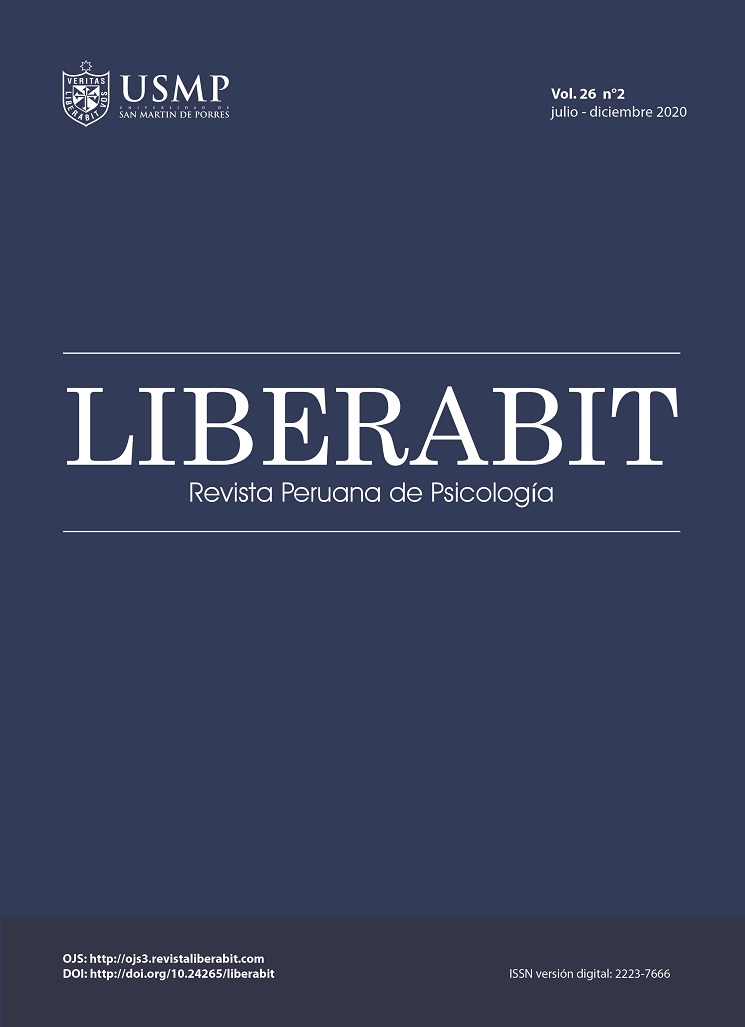Emoción, memoria y comprensión lectora en alumnos de escuelas secundarias
DOI:
https://doi.org/10.24265/liberabit.2020.v26n2.02Palabras clave:
comprensión del texto, emoción, memoria, enseñanza secundariaResumen
Antecedentes: aunque se ha verificado experimentalmente la existencia de efectos específicos de la emoción sobre comprensión de textos en adultos, no existe información referida a adolescentes, lo cual resulta relevante con vistas al diseño de intervenciones. Objetivo: el objetivo de la presente investigación es evaluar si los estados emocionales conceptualizados dimensionalmente (valencia, activación y dominancia) afectan la comprensión y la recuperación de textos escritos en adolescentes. Método: tras la validación de instrumentos, se realizaron 3 experimentos (n = 468) en los cuales se indujeron emociones que diferían en una dimensión (valencia, activación o dominancia) y mantenían estables las demás, de forma de poder evaluar el rol independiente de cada una sobre los procesos de comprensión y recuperación (i.e. valencia positiva vs. negativa, activación y dominancia estable en experimento 1). Resultados: los resultados mostraron que la valencia tiene un efecto sobre la comprensión de textos, con mejor desempeño en condiciones de inducción emocional positiva que en la negativa. Por su parte, la activación ocupa un rol central en los procesos de memoria de forma independiente a otras dimensiones emocionales, siendo mayor la recuperación en estados de activación alta. Por último, la dominancia en sí misma no mostró tener efectos significativos. Conclusiones: los resultados permiten inferir que la valencia del estado emocional se vincula mayormente con procesos de razonamiento e inducción mientras que la activación se asocia a cambios en los procesos de almacenamiento y recuperación de la información.
Contribución de autoría
MS: concepción y diseño del estudio, administración de las técnicas, interpretación de los datos y revisión final del manuscrito.
NI: supervisión del diseño de investigación, asesoría estadística, discusión y revisión final del manuscrito.
Descargas
Referencias
in Experimental Social Psychology (Vol. 41, pp. 167- 218). doi: 10.1016/S0065-2601(08)00404-8
Barrett, L. F., Lewis, M., & Haviland-Jones, J. M. (Eds.). (2016). Handbook of Emotions. Guilford Publications.
Bless, H., & Fiedler, K. (2006). Mood and the Regulation of Information Processing and Behavior. Sydney
Symposium of Social Psychology Series, 8, 65-84. Psychology Press.
Bradley, M., & Lang, P. J. (2007). Emotion and Motivation. In J. T. Cacioppo, L. G. Tassinary, & G. Berntson (Eds.), Handbook of Psychophysiology (pp. 581-607). Cambridge: Cambridge University Press.
Bohn-Gettler, C. M., & Rapp, D. N. (2011). Depending on my Mood: Mood-Driven Influences on Text Comprehension. Journal of educational psychology, 103(3), 562-577. doi: 10.1037/a0023458
Bowen, H. J., Kark, S. M., & Kensinger, E. A. (2018). NEVER Forget: Negative Emotional Valence Enhances
Recapitulation. Psychonomic Bulletin & Review, 25(3), 870-891.
Bower, G. H. (1981). Mood and Memory. American Psychologist, 36(2), 129-148. doi: 10.1037/0003-
066X.36.2.129 Boyle, G. J. (1986). Depressed Mood Effects on Processing of High-and Low-Content Structure Text in American and Australian College Women. Journal of structural learning, 9, 77-82. Recuperado de
https:// works.bepress.com/greg_boyle/149/download/
Burke, A., Heuer, F., & Reisberg, D. (1992). Remembering Emotional Events. Memory & Cognition, 20(3), 277- 290.
doi: 10.3758/BF03199665
Christianson, S. Å. (1984). The Relationship between Induced Emotional Arousal and Amnesia. Scandinavian Journal of Psychology, 25(2), 147-160. doi: 10.1111/j.1467-9450.1984.tb01007.x
Christianson, S. Å., & Loftus, E. F. (1987). Memory for Traumatic Events. Applied Cognitive Psychology, 1(4), 225-239. doi: 10.1002/acp.2350010402
Clark, M. S., Milberg, S., & Ross, J. (1983). Arousal Cues Arousal-Related Material in Memory: Implications for
Understanding Effects of Mood on Memory. Journal of Verbal Learning and Verbal Behaviour, 22, 633-649.
doi: 10.1016/s0022-5371(83)90375-4
Cudo, A., Francuz, P., Augustynowicz, P., & Strózak, P. (2018). The Effects of Arousal and Approach
Motivated Positive Affect on Cognitive Control. An ERP Study. Frontiers in Human Neuroscience, 12.
doi: 10.3389/fnhum.2018.00320
Damasio, A. R. (1996). The Somatic Marker Hypothesis and the Possible Functions of the Prefrontal Cortex. Phiosophical Transactions: Biological Sciences, 351(1346), 1413-1420. doi: 10.1093/acprof:oso/
9780198524410.003.0004
Ellis, H. C., Ottaway, S. A., Varner, L. J., Becker, A. S., & Moore, B. A. (1997). Emotion, Motivation, and Text Comprehension: The Detection of Contradictions in Passages. Journal of Experimental Psychology: General, 126(2), 131-146. doi: 10.1037/0096-344
5.126.2.131
Ellis, H. C., Varner, L. J., Becker, A. S., & Ottaway, S. A. (1995). Emotion and Prior Knowledge in Memory and Judged Comprehension of Ambiguous Stories. Cognition & Emotion, 9(4), 363-382. doi: 10.1080/02699939508408972
Forgas, J. P. (1995). Mood and Judgment: The Affect Infusion Model (AIM). Psychological Bulletin, 117(1), 39-66.
doi: 10.1037/0033-2909.117.1.39
García-García, M. Á., Arévalo-Duarte, M. A., & HernándezSuárez, C. A. (2018). La comprensión lectora y el rendimiento escolar. Cuadernos de Lingüística Hispánica, 32, 155-174. doi: 10.19053/0121053 X.n32.2018.8126
Heuer, F., & Reisberg, D. (1990). Vivid Memories of Emotional Events: The Accuracy of Remembered Minutiae. Memory & Cognition, 18(5), 496-506. doi: 10.3758/ bf03198482
Irrazabal, N., Aranguren, M., Zaldúa, E., & Di Giuliano, N. (2015). Datos normativos del Sistema Internacional de Imágenes Afectivas (IAPS) en una muestra argentina. Revista Argentina de Ciencias del Comportamiento, 7(3), 34-50.
Keltner, D., Tracy, J. L., Sauter, D., & Cowen, A. (2019). What Basic Emotion Theory Really Says for the
Twenty-First Century Study of Emotion. Journal of Nonverbal Behavior, 43(2), 195-201. doi: 10.1007/s10 919-019-00298-y
Kensinger, E. A. (2004). Remembering Emotional Experiences: The Contribution of Valence and Arousal. Reviews in
the Neurosciences, 15(4), 241-251. doi: 10.1515/revneur o.2004.15.4.241
Kensinger, E. A. (2009). Remembering the Details: Effects of Emotion. Emotion Review, 1(2), 99-113. doi: 10.1177/
1754073908100432 Kensinger, E. A., & Corkin, S. (2004). Two Routes to Emotional Memory: Distinct Neural Processes for Valence and Arousal. Proceedings of the National Academy of Sciences, 101(9), 3310-3315.
doi: 10.1073/ pnas.0306408101
Kuhbandner, C., & Zehetleitner, M. (2011). Dissociable Effects of Valence and Arousal in Adaptive Executive Control. PLoS ONE, 6(12), e29287. doi: 10.1371/journal.pone.0029287
Kuhbandner, C., & Pekrun, R. (2013) Affective State Influences Retrieval-Induced Forgetting for Integrated Knowledge. PLoS ONE, 8(2), e56617. doi: 10.1371/ journal.pone.0056617
Lang, P. J., Bradley, M. M., & Cuthbert, B. N. (1999). International Affective Picture System (IAPS): Instruction Manual and Affective Ratings. Gainesville, FL: The Center for Research in Psychophysiology, University of Florida.
Libkuman, T. M., Stabler, C. L., & Otani, H. (2004). Arousal, Valence, and Memory for Detail. Memory, 12(2), 237- 247.
doi: 10.1080/09658210244000630
Llorens, A. C., Gil, L., Vidal-Abarca, E., Martínez, T., Mañá, A., & Gilabert, R. (2011). Prueba de Competencia Lectora para Educación Secundaria (CompLEC). Psicothema, 23(4), 808-817. Recuperado de https:// www.unioviedo.net/reunido/index.php/PST/article/ download/9163/9027
Madan, C. R., Fujiwara, E., Caplan, J. B., & Sommer, T. (2017). Emotional arousal impairs association-memory: Roles of Amygdala and Hippocampus. NeuroImage, 156, 14-28. doi: 10.1016/j.neuroimage.2017.04.065
Madan, C. R., Scott, S. M., & Kensinger, E. A. (2019). Positive Emotion Enhances AssociationMemory. Emotion, 19(4), 733-740. doi: 10.1037/emo 0000465
Mina, L., Bakker, L., Rubiales, J., & González, R. (2017). Estudio de validación del International Affective Picture System en niños y adolescentes argentinos. Revista de Psicología, 26(2), 76-91. doi: 10.5354/0719- 0581.2017.47953
Osgood, C., Suci, G., & Tannenbaum, P. (1957). The Measurement of Meaning. Urbana, IL: University of Illinois.
Okon-Singer, H., Stout, D. M., Stockbridge, M. D., Gamer, M., Fox, A. S., & Shackman, A. J. (2017). The Interplay of Emotion and Cognition. In A. S. Fox, R. C. Lapate, A. J. Shackman, & R. J. Davidson (Eds.), The Nature of Emotion. Fundamental questions (2a ed.). New York: Oxford University Press
Panksepp, J. (1991). Affective Neuroscience: A Conceptual Framework for the Neurobiological Study of Emotions. In K. Strongman (Ed.), International Reviews of Emotion Research (pp. 59-99). Chichester, UK: Wiley.
Perdomo, J., & Fernández, A. (2018). Estudio exploratorio de las emociones en la cotidianidad de las clases de matemáticas. Revista Electrónica de Investigación Educativa, 20(4), 133-143. doi: 10.24320/redie.2018.2 0.4.1748
Posner, J., Russell, J. A., & Peterson, B. S. (2005). The Circumplex Model of Affect: An Integrative Approach to Affective Neuroscience, Cognitive Development, and Psychopathology. Development and Psychopathology, 17(3), 715-734. doi: 10.1017/S0954579405050340
Robinson, M. D., Storbeck, J., Meier, B. P., & Kirkeby, B. S. (2004). Watch out! That Could Be Dangerous: Valence-Arousal Interactions in Evaluative Processing. Personality and Social Psychology Bulletin, 30(11), 1472-1484.
doi: 10.1177/0146167204266647
Russell, J. A. (1980). A Circumplex Model of Affect. Journal of Personality and Social Psychology, 39(6), 1161- 1178.
doi: 10.1037/h0077714
Russell, J. A., & Mehrabian, A. (1977). Evidence for a Three-Factor Theory of Emotions. Journal of Research in Personality, 11(3), 273-294. doi: 10.1016/0092- 6566(77)90037-X
Sambuco, N., Bradley, M. M., Herring, D. R., & Lang, P. J. (2020). Common Circuit or Paradigm Shift? The Functional Brain in Emotional Scene Perception and Emotional Imagery. Psychophysiology, 57(4), e13522. doi: 10.1111/psyp.13522
Schindler, J., Richter, T., & Eyßer, C. (2017). Mood Moderates the Effect of Self-Generation During Learning. Frontline Learning Research, 5(4), 76-88. doi: 10.14786/flr.v5i4.296
Storbeck, J., & Clore, G. L. (2008). Affective Arousal as Information: How Affective Arousal Influences Judgments, Learning, and Memory. Social and Personality Psychology Compass, 2(5), 1824-1843. doi: 10.1111/j.1751-9004.2008.00138.x
Sutherland, M. R., & Mather, M. (2018). Arousal (but Not Valence) Amplifies the Impact of Salience. Cognition and Emotion, 32(3), 616-622. doi: 10.1080/0269993 1.2017.1330189
Tornare, E., Cuisinier, F., Czajkowski, N. O., & Pons, F. (2016). Impact of Induced Joy on Literacy in Children: Does the Nature of the Task Make a Difference? Cognition and Emotion, 31(3), 500-510. doi: 10.1080/ 02699931.2015.1132682
Velten, E. (1968). A Laboratory Task for Induction of Mood States. Behaviour Research and Therapy, 6(4), 473- 482. doi:10.1016/0005-7967(68)90028-4
Vergara-Morales, J., Valle, M. del, Díaz, A., Matos, L., & Pérez, M. V. (2019). Efecto mediador de la motivación autónoma en el aprendizaje. Revista Electrónica de Investigación Educativa, 21, e37. doi: 10.24320/redie.2019.21.e37.2131
Wen, T. J., Morris, J. D., & Sherwood, M. (2018). The Psychological Processes of Mixed Valence Images: Emotional Response, Visual Attention, and Memory.Visual Communication Quarterly, 25(4), 225-239. doi: 10.1080/15551393.2018.1530599
Yüvrük, E., Kapucu, A., & Amado, S. (2020). The Effects of Emotion on Working Memory: Valence versus Motivation. Acta Psychologica, 202, 102983. doi: 10.1016/j.actpsy.2019.102983
Publicado
Número
Sección
Licencia
Derechos de autor: En caso de que el manuscrito sea aprobado para su publicación, los autores conservarán los derechos de autoría y cederán a la revista los derechos de publicación, edición, reproducción, distribución, exhibición y comunicación a nivel nacional e internacional en las diferentes bases de datos, repositorios y portales.
Política de autoarchivo: El autor puede compartir, difundir y divulgar sus investigaciones publicadas por los medios de comunicación (e.g., redes sociales académicas, repositorios y portales) disponibles en la web. Durante el proceso de revisión editorial, la revista entregará al autor las versiones previas (post-print), las cuales NO deben ser divulgadas por ningún medio de difusión y son solo de uso personal con fines de aprobación final. Liberabit enviará al autor la versión final del artículo (published version) en formato PDF y HTML para ser compartida, difundida y divulgada por los medios de comunicación disponibles en la web. Después de la publicación de los artículos, los autores pueden realizar acuerdos independientes o adicionales para la difusión no exclusiva de la versión del artículo publicado en la revista (por ejemplo, publicación en libros o repositorios institucionales), siempre que se indique con la referencia respectiva que el trabajo ha sido publicado por primera vez en esta revista.











